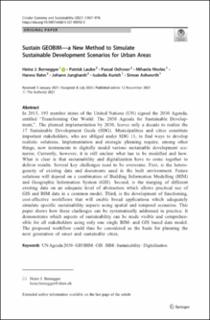Please use this identifier to cite or link to this item:
https://doi.org/10.21256/zhaw-23957Full metadata record
| DC Field | Value | Language |
|---|---|---|
| dc.contributor.author | Bernegger, Heinz | - |
| dc.contributor.author | Laube, Patrick | - |
| dc.contributor.author | Ochsner, Pascal | - |
| dc.contributor.author | Meslec, Mihaela | - |
| dc.contributor.author | Rahn, Hanno | - |
| dc.contributor.author | Junghardt, Johann | - |
| dc.contributor.author | Aurich, Isabella | - |
| dc.contributor.author | Ashworth, Simon | - |
| dc.date.accessioned | 2022-01-20T14:11:40Z | - |
| dc.date.available | 2022-01-20T14:11:40Z | - |
| dc.date.issued | 2021-11 | - |
| dc.identifier.issn | 2730-597X | de_CH |
| dc.identifier.issn | 2730-5988 | de_CH |
| dc.identifier.uri | https://digitalcollection.zhaw.ch/handle/11475/23957 | - |
| dc.description.abstract | In 2015, 193 member states of the United Nations (UN) signed the 2030 Agenda, entitled “Transforming Our World: The 2030 Agenda for Sustainable Development,”. The planned implementation by 2030, leaves only a decade to realize the 17 Sustainable Development Goals (SDG). Municipalities and cities constitute important stakeholders, who are obliged under SDG 11, to find ways to develop realistic solutions. Implementation and strategic planning require, among other things, new instruments to digitally model various sustainable development scenarios. Currently, however, it is still unclear what has to be modelled and how. What is clear is that sustainability and digitalization have to come together to deliver results. Several key challenges need to be overcome. First, is the heterogeneity of existing data and documents used in the built environment. Future solutions will depend on a combination of Building Information Modelling (BIM) and Geographic Information System (GIS). Second, is the merging of different existing data on an adequate level of abstraction which allows practical use of GIS and BIM data in a common model. Third, is the development of functioning, cost-effective workflows that will enable broad applications which adequately simulate specific sustainability aspects using spatial and temporal scenarios. This paper shows how these challenges can be systematically addressed in practice. It demonstrates which aspects of sustainability can be made visible and comprehensible for all stakeholders using only one single BIM- and GIS based data model. The proposed workflow could thus be considered as the basis for planning the next generation of smart and sustainable cities. | de_CH |
| dc.language.iso | en | de_CH |
| dc.publisher | Springer | de_CH |
| dc.relation.ispartof | Circular Economy and Sustainability | de_CH |
| dc.rights | https://creativecommons.org/licenses/by/4.0/ | de_CH |
| dc.subject | UN Agenda 2030 | de_CH |
| dc.subject | GEOBIM | de_CH |
| dc.subject | GIS | de_CH |
| dc.subject | BIM | de_CH |
| dc.subject | Sustainability | de_CH |
| dc.subject | Digitalisation | de_CH |
| dc.subject.ddc | 338.927: Umweltökonomie und nachhaltige Entwicklung | de_CH |
| dc.title | Sustain GEOBIM – a new method to simulate sustainable development scenarios for urban areas | de_CH |
| dc.type | Beitrag in wissenschaftlicher Zeitschrift | de_CH |
| dcterms.type | Text | de_CH |
| zhaw.departement | Life Sciences und Facility Management | de_CH |
| zhaw.organisationalunit | Institut für Facility Management (IFM) | de_CH |
| zhaw.organisationalunit | Institut für Umwelt und Natürliche Ressourcen (IUNR) | de_CH |
| dc.identifier.doi | 10.1007/s43615-021-00092-3 | de_CH |
| dc.identifier.doi | 10.21256/zhaw-23957 | - |
| zhaw.funding.eu | No | de_CH |
| zhaw.issue | 3 | de_CH |
| zhaw.originated.zhaw | Yes | de_CH |
| zhaw.pages.end | 976 | de_CH |
| zhaw.pages.start | 967 | de_CH |
| zhaw.publication.status | publishedVersion | de_CH |
| zhaw.volume | 1 | de_CH |
| zhaw.publication.review | Peer review (Publikation) | de_CH |
| zhaw.webfeed | Geoinformatik | de_CH |
| zhaw.funding.zhaw | GeoBIM Campus N IUNR | de_CH |
| zhaw.author.additional | No | de_CH |
| zhaw.display.portrait | Yes | de_CH |
| Appears in collections: | Publikationen Life Sciences und Facility Management | |
Files in This Item:
| File | Description | Size | Format | |
|---|---|---|---|---|
| 2021_Bernegger-etal_Sustain-GEOBIM_CircEconSust.pdf | 458.07 kB | Adobe PDF |  View/Open |
Show simple item record
Bernegger, H., Laube, P., Ochsner, P., Meslec, M., Rahn, H., Junghardt, J., Aurich, I., & Ashworth, S. (2021). Sustain GEOBIM – a new method to simulate sustainable development scenarios for urban areas. Circular Economy and Sustainability, 1(3), 967–976. https://doi.org/10.1007/s43615-021-00092-3
Bernegger, H. et al. (2021) ‘Sustain GEOBIM – a new method to simulate sustainable development scenarios for urban areas’, Circular Economy and Sustainability, 1(3), pp. 967–976. Available at: https://doi.org/10.1007/s43615-021-00092-3.
H. Bernegger et al., “Sustain GEOBIM – a new method to simulate sustainable development scenarios for urban areas,” Circular Economy and Sustainability, vol. 1, no. 3, pp. 967–976, Nov. 2021, doi: 10.1007/s43615-021-00092-3.
BERNEGGER, Heinz, Patrick LAUBE, Pascal OCHSNER, Mihaela MESLEC, Hanno RAHN, Johann JUNGHARDT, Isabella AURICH und Simon ASHWORTH, 2021. Sustain GEOBIM – a new method to simulate sustainable development scenarios for urban areas. Circular Economy and Sustainability. November 2021. Bd. 1, Nr. 3, S. 967–976. DOI 10.1007/s43615-021-00092-3
Bernegger, Heinz, Patrick Laube, Pascal Ochsner, Mihaela Meslec, Hanno Rahn, Johann Junghardt, Isabella Aurich, and Simon Ashworth. 2021. “Sustain GEOBIM – a New Method to Simulate Sustainable Development Scenarios for Urban Areas.” Circular Economy and Sustainability 1 (3): 967–76. https://doi.org/10.1007/s43615-021-00092-3.
Bernegger, Heinz, et al. “Sustain GEOBIM – a New Method to Simulate Sustainable Development Scenarios for Urban Areas.” Circular Economy and Sustainability, vol. 1, no. 3, Nov. 2021, pp. 967–76, https://doi.org/10.1007/s43615-021-00092-3.
Items in DSpace are protected by copyright, with all rights reserved, unless otherwise indicated.